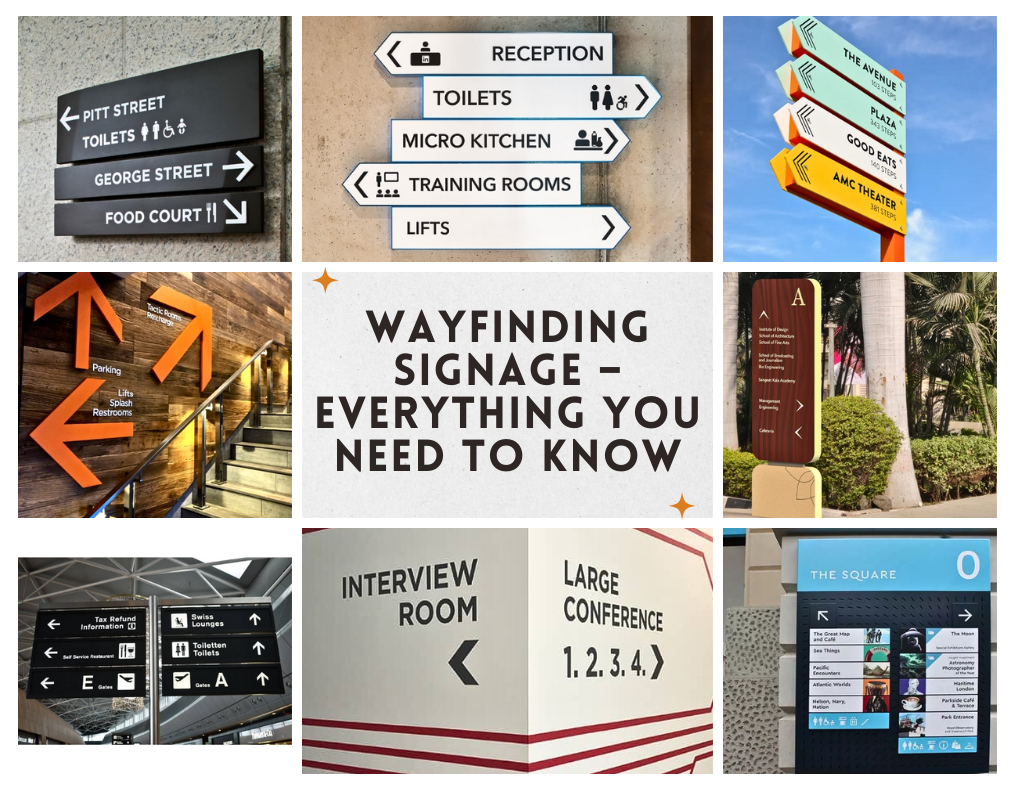
The Ultimate Guide to Directional Signs: Enhancing Navigation and Customer Experience
Estimated reading time: 8 minutes
Key Takeaways
- Directional signs are essential tools for efficient navigation and enhancing customer experience.
- The choice of materials significantly affects the durability and visual appeal of directional signage.
- Effective design and installation of directional signs support brand identity and comply with regulations.
- Regular maintenance is crucial for the longevity and effectiveness of directional signage.
- Implementing directional sign systems can lead to improved customer satisfaction and operational efficiency.
Table of Contents
- What is a Directional Sign?
- Main Materials Used for Directional Signage
- Purpose of Directional Signs for Business
- Designing Effective Directional Signs
- Installation and Maintenance of Directional Signs
- Success Stories and Examples
- Conclusion
- Frequently Asked Questions
What is a Directional Sign?
A directional sign is a specialized type of wayfinding signage designed to help people navigate through spaces effectively. Unlike other signs that simply identify locations, directional signs actively guide visitors along their journey.
Common applications include:
- Arrows pointing to specific destinations
- Floor-level pathway markers
- Overhead suspended signs
- Wall-mounted directional panels
- Digital wayfinding displays
You’ll find these navigation aids in various locations, including:
- Shopping malls and retail centers
- Airports and transportation hubs
- Healthcare facilities
- Educational campuses
- Corporate office buildings
- Entertainment venues
Main Materials Used for Directional Signage
The effectiveness of directional signs heavily depends on the materials used in their construction. Here are the most common options:
Metal
- Highly durable
- Weather-resistant
- Professional appearance
- Ideal for outdoor use
- Higher cost
Acrylic
- Modern aesthetic
- Lightweight
- Cost-effective
- Suitable for indoor use
- Various color options
Wood
- Natural appearance
- Customizable
- Warm aesthetic
- Requires more maintenance
- Better for indoor use
Plastic
- Affordable
- Lightweight
- Easy to replace
- Multiple design options
- Less durable than metal
When selecting materials, consider:
- Environmental conditions
- Budget constraints
- Aesthetic requirements
- Expected lifespan
- Maintenance needs
Purpose of Directional Signs for Business
Business directional signs serve multiple crucial functions:
Customer Experience Enhancement
- Reduce visitor frustration
- Minimize time spent searching
- Increase customer satisfaction
- Improve accessibility
- Support independent navigation
Brand Identity Support
- Reinforce company colors
- Display consistent messaging
- Integrate corporate design elements
- Enhance professional appearance
- Build brand recognition
Regulatory Compliance
- Meet ADA requirements
- Follow safety regulations
- Ensure proper emergency routing
- Support risk management
- Maintain legal standards
Designing Effective Directional Signs
Creating effective directional signs design requires careful consideration of several key elements:
Clarity
- Use simple, readable fonts
- Maintain adequate spacing
- Include clear directional arrows
- Limit text content
- Ensure high contrast
Visibility
- Position at eye level when possible
- Use appropriate sizing
- Consider lighting conditions
- Avoid visual obstacles
- Maintain clear sightlines
Brand Consistency
- Use corporate colors
- Include logo elements
- Match other signage
- Follow brand guidelines
- Maintain professional appearance
Installation and Maintenance of Directional Signs
Proper installation and maintenance ensure long-lasting effectiveness of your directional signage.
Installation Best Practices
- Follow manufacturer guidelines
- Consider viewing angles
- Ensure secure mounting
- Account for traffic flow
- Meet height requirements
Maintenance Tips
- Regular cleaning schedule
- Prompt repair of damage
- Periodic inspection
- Update as needed
- Document maintenance
Success Stories and Examples
Healthcare Facility Case Study
A major hospital implemented a comprehensive directional sign system that reduced patient confusion by 45% and decreased staff time spent giving directions by 60%.
Airport Implementation
An international airport’s new wayfinding system decreased missed flights due to navigation issues by 30% and improved customer satisfaction ratings by 25%.
Shopping Center Success
A retail complex saw a 15% increase in store visits after implementing clear directional signage throughout the facility.
Conclusion
Directional signs are fundamental tools for creating efficient, user-friendly spaces that enhance navigation and improve customer experience. By understanding the materials, design principles, and best practices for installation and maintenance, businesses can implement effective directional signage systems that serve their visitors well while supporting their brand identity.
Whether you’re managing a small retail space or a large complex facility, investing in quality directional signs will pay dividends in improved customer satisfaction and operational efficiency. Remember that successful directional signage requires careful planning, proper implementation, and regular maintenance to maintain its effectiveness over time.
Take the time to evaluate your current directional signage system and consider how improvements might benefit your organization and those who navigate your space.
Frequently Asked Questions
What are directional signs?
Directional signs are specialized wayfinding tools designed to guide individuals from one point to another within various spaces, enhancing navigation and improving customer experience.
What materials are commonly used for directional signage?
The most common materials include metal, acrylic, wood, and plastic, each offering different levels of durability, aesthetics, and suitability for indoor or outdoor use.
How do directional signs enhance customer experience?
They reduce visitor frustration, minimize time spent searching for destinations, increase satisfaction, improve accessibility, and support independent navigation.
What are best practices for designing directional signs?
Ensure clarity by using simple fonts and clear arrows, maintain visibility with appropriate sizing and lighting, and maintain brand consistency with corporate colors and design elements.
How should directional signs be maintained?
They should be regularly cleaned, promptly repaired if damaged, periodically inspected, updated as needed, and their maintenance should be documented to ensure ongoing effectiveness.
